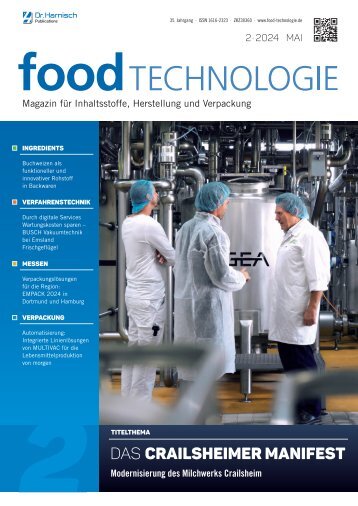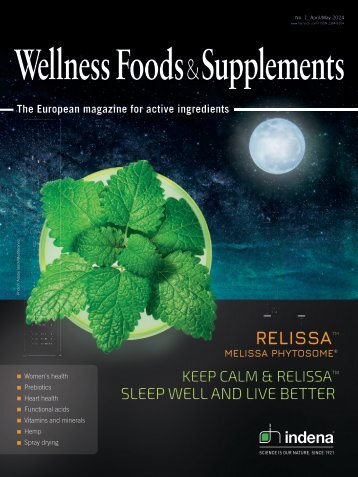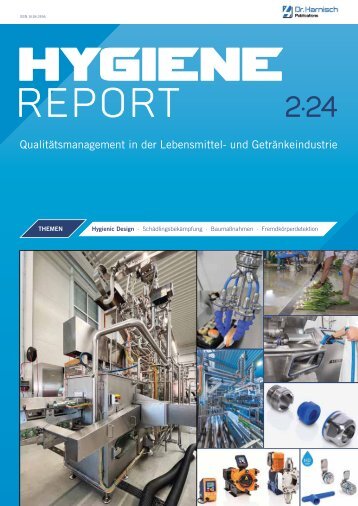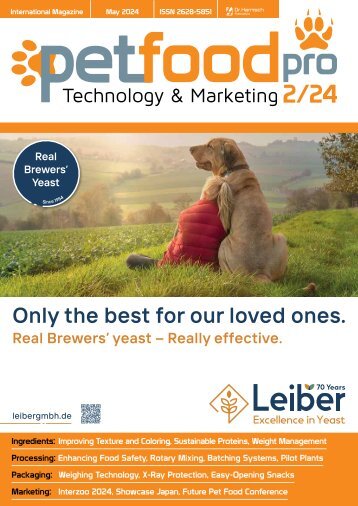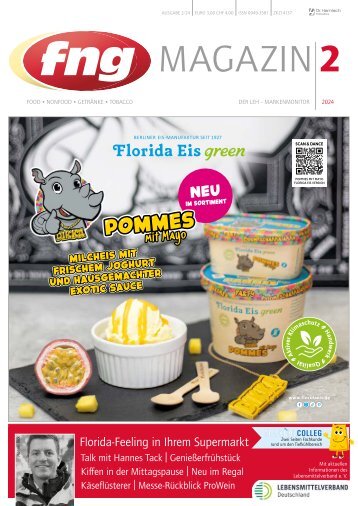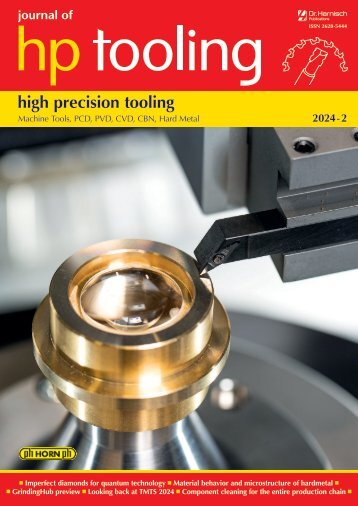food Marketing & Technology 2/2022
- Text
- Harnischcom
- Germany
- Packaging
- Ingredients
- Processing
- Coconut
- Consumers
- Products
- April
- Marketing
- Efficiency
Marketing E-Numbers – Cleaner than Clean Label -If only Consumers Knew by Nesha Zalesny & Dennis Seisun Nowadays food processors have to meet an increasing number of consumer demands and expectations. Taste, texture and price used to be the primary considerations for a successful new product launch in processed food. In the last 25-30 years, however, a plethora of other requirements been added to the ‘Must have’ list for success. IMR has often stated, the battle for consumer minds has shifted to the label. Several components of processed food labels are now critical to consumer choice. These components can be classified by 1) nutritional concerns: are the ingredients and additives nutritious and maybe even beneficial? 2) Social concerns: Are they ‘Fair Trade’? Are they produced in a politically sensitive part of the world? And finally 3) ingredient production concerns: Are they GMO free? Better still are they organic which usually means GMO free and produced by organic farming methods. As if these were not enough requirements which a food processor has to consider, an all-encompassing yet nebulous requirement has become a mantra for consumers which food processors must try and meet:- Are the ingredients “Clean”, is the declared list a “Clean Label”? Of course, food safety remains paramount and should go without saying but it’s worth mentioning. In Europe, because of the multinational nature of the European Union, a list of “E-Numbers” has been developed. The E-Numbers are used as shorthand to allow labels that could be interpreted easily in any of the many languages of the EU. In the US and other parts of the world the name of the ingredient or its ‘common and usual’ equivalent must be listed on the label. Whichever label declaration method is used a long list of ingredients or E-numbers is often necessary on the label. This article will delve into how food processors attempt to satisfy the multitude of expectations, sometimes contradictory, which consumers have. Be prepared for some thought provoking reading, not all of which you will agree with, but hopefully all of which will generate discussion. We will make the case that a long list of e-number ingredients is not necessarily a bad thing. Indeed it may be a good thing. The challenge is to make consumers aware. Let us start with the definitions of “E-Numbers” and “Clean Label”. According to Wikipedia:- “E-Numbers are codes for substances used as food additives in the European Union (EU) and the European Free Trade Association (EFTA). Their safety assessment and approval are the responsibility of the European Food Safety Authority (EFSA). In some European countries, “E number” is sometimes used informally as a pejorative term for artificial food additives, and products may promote themselves as “free of E numbers”. This is incorrect, because many components of natural foods have assigned E numbers (and the number is a synonym for the chemical component), e.g. vitamin C (E300) and lycopene (E160d), found in carrots Also according to Wikipedia:- A clean label is a label on a food, not listing ingredients that may be perceived by consumers as 46 food Marketing & Technology • April 2022
Marketing undesirable. The purpose is to give food products a natural, healthy appearance and to stimulate sales. It does not necessarily mean that the product is free from additives, as they can be hidden in substituting ingredients. Wikipedia does not mention that E-number designations and approvals are based on rigorous testing for efficacy and safety. All kinds of studies and supporting documents must be submitted to regulatory authorities. Approval bodies such as the European Food Safety Authority (EFSA) or, in the USA, the Food and Drug Administration (FDA) are staffed by highly qualified scientists. On the other hand, the concept of clean label is based purely on the perception which consumers have about what is “clean”. Consumer perceptions can, and often are, influenced by unreliable and poorly informed sources. Friends, relatives, blogs, twitter feeds, and social media influencers are frequently the foundation of consumer perceptions and beliefs about what is good and what is bad about food and food additives. Some will argue that a cleaner label is one that simply declares fewer ingredients on the label. Others might say that designations like ‘GMO free’, ‘organic’, ‘fair trade’ are all requirements to make a food label ‘cleaner’. To be clear, however, there is no accepted universal standard for what constitutes a clean label and what could make it cleaner. Consumers have different standards and definitions A little like the fact that there is no definition of the oft used term ‘natural’. No wonder consumers are confused. They should be in view of the liberties which are taken on food labels in the pursuit of the clean label mantra. Consumers do not give enough weight to the difficulty and rigorous testing that EFSA requires before giving a stamp of approval in the form of an E-Number. Such approvals take years, a plethora of safety studies including expensive feeding studies and of course millions of Euros/dollars to fund the effort. Regulatory authorities in other parts of the world are not much less rigorous in granting food additive approvals. Many countries, in fact, use FDA or EFSA findings as a basis for food additive approval. Often the approval process for a food ingredient or additive is not very different from a pharmaceutical authorization except that it does not have to support a medical treatment or cure. In the efforts to ‘clean up’ a food label, food processors have sought approval for an extended set of ingredients under a ‘Generally Recognized as Safe – GRAS’ petition in the US and/or a ‘Novel Food’ application in the EU. The dossiers of research and supporting studies are extensive but not to the same degree as E-number approval in Europe and a food additive petition (FAP) in the US. IMR has often mentioned the concept of ‘in-situ’ hydrocolloid production in the pursuit of a clean label mantra. The in-situ concept refers to the fact that a certain ingredient or additive may be contained as part of another ingredient, OR that it may be generated during the processing/packaging of the food. A Technology & Marketing International Magazine June 2020 ISSN 2628-5851 2/20 PetFood PRO magazine wants to emphasize the high level of quality International Magazine April 2020 ISSN 2628-5851 1/20 and care in the production of pet food through the choice of ingredients, the choice of technology and the choice Ingredients: Hydrocolloids in Pet Food, Acacia Gum's Versatility, Antioxidants Processing: Optical Sorting, Gentle Cooling, Removing Risks in Food Safety Packaging: Pouches and Printing, Sustainability, Choosing the Right Bags Marketing: Ask the Vet, Company News, Updates From the Fairs of packaging materials. Ingredients Indispensable Fatty Acids, Dietary Fiber for Pets, Yeast Processing HPP Technology, Extruding Fish Feed, Encapsulation Packaging Canning, Recyclable Bags, Cartons Marketing The Vet's Corner, News from Fairs and Firms www.harnisch.com food Marketing & Technology • April 2022 47
- Seite 1 und 2: 2/22 Vol. 36 • 31377 ISSN 0932-27
- Seite 3 und 4: Editorial Rewarding Moments There a
- Seite 5 und 6: Vol. 36 • 31377 ISSN 0932-2744 Co
- Seite 7 und 8: Cover Story The key to their flexib
- Seite 9 und 10: Cover Story THE LIGHTLINE PICKERLIN
- Seite 11 und 12: Ingredients Available in a range of
- Seite 13 und 14: Ingredients of the Department of Bi
- Seite 15 und 16: Ingredients temperature: at tempera
- Seite 17 und 18: Ingredients Hacking the food supply
- Seite 19 und 20: Transforming global food production
- Seite 21 und 22: Events potential partners and suppl
- Seite 23 und 24: Processing The Sachsenmilch Leppers
- Seite 25 und 26: Processing PLANT BASED PRODUCT INNO
- Seite 27 und 28: Processing TOMRA’s sorters detect
- Seite 29 und 30: Processing Measurement Technology:
- Seite 31 und 32: Processing installed base are autom
- Seite 33 und 34: ai164822761615_ASH228 INTL_Food_Mar
- Seite 35 und 36: Processing Packaging We bring colou
- Seite 37 und 38: Processing Energy Efficiency up to
- Seite 39 und 40: Events Processing technologies - am
- Seite 41 und 42: Events “Smart Impulses for a Digi
- Seite 43 und 44: Events builds trust. Networked prod
- Seite 45 und 46: Events Anuga FoodTec, Cologne, Hall
- Seite 47: Events Anuga FoodTec, Cologne, Hall
- Seite 51 und 52: Marketing DataPhysics Instruments i
- Seite 53 und 54: Axial split modular casing on steel
- Seite 55 und 56: Packaging diverse, inspiring and ex
- Seite 57 und 58: Josef Rettenmaier 1924 - 2022 Josef
- Seite 59 und 60: Events Connect with nutraceutical e
- Seite 61 und 62: Innovations in Meat Vol. 36 • 313
Unangemessen
Laden...
Magazin per E-Mail verschicken
Laden...
Einbetten
Laden...








































